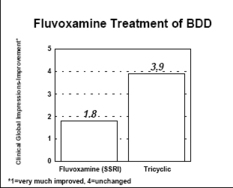Although the diagnostic manual of the American Psychiatric Association categorizes pathological gambling as an impulse control disorder, clinicians are often struck by the similarities and overlapping symptomatology of pathological gambling with disorders from other psychiatric categories. For example, Hollander & Wong explore the parallels between body dysmorphic disorder (BDD), sexual disorders, and pathological gambling within the realm of obsessive-compulsive disorders. BDD is a chronic condition characterized by a preoccupation with an imagined defect in one’s appearance (e.g., perceived facial flaws, body size abnormalities) and often leads to surgical procedures and compulsive rituals to conceal or correct the perceived defect. An estimated 0.1-1% of the population suffers from BDD. Treatment studies suggest that SSRIs (selective serotonin reuptake inhibitors) are more successful than standard neuroleptics, benzodiazepines, tricyclics, and anti-convulsants in treating this disorder as measured by the Clinical Global Impressions & Improvement scale (see figure below). Sexual disorders can take the form of sexual obsessions (intrusive, repetitive, and vivid sexual images that are anxiety-provoking), sexual impulsions (repetitive images or behavior that are pleasure-producing), or paraphilias (sexual fantasies or acts that involve arousal from inappropriate objects or partners). Patients with sexual obsessions improved when treated with SSRIs, while those with sexual impulsions and paraphilias displayed a mixed response. Hollander & Wong argue that pathological gambling shares characteristics with obsessive-compulsive disorders, as pathological gamblers complain of a compulsion to gamble and often are unsuccessful in resisting impulses to gamble. If pathological gambling is similar to BDD, we can expect SSRIs to be successful in treating pathological gambling. In addition, it is important to determine which criteria are sufficient for including a cluster of disorders under the same category. That is, are parallels in the etiology, treatment response, and neurobiology of two disorders enough to determine that they represent related expressions of the same underlying disorder?
Source: Hollander, E., & Wong, C.M. (1995). Body dysmorphic disorder, pathological gambling, and sexual compulsions. Journal of Clinical Psychiatry, 56(Suppl. 4), 7-12.
This public education project is funded, in part, by The Andrews Foundation.
This fax may be copied without permission. Please cite The WAGER as the source.
For more information contact the Massachusetts Council on Compulsive Gambling, 190 High Street, Suite 6, Boston, MA 02110, U.S.





